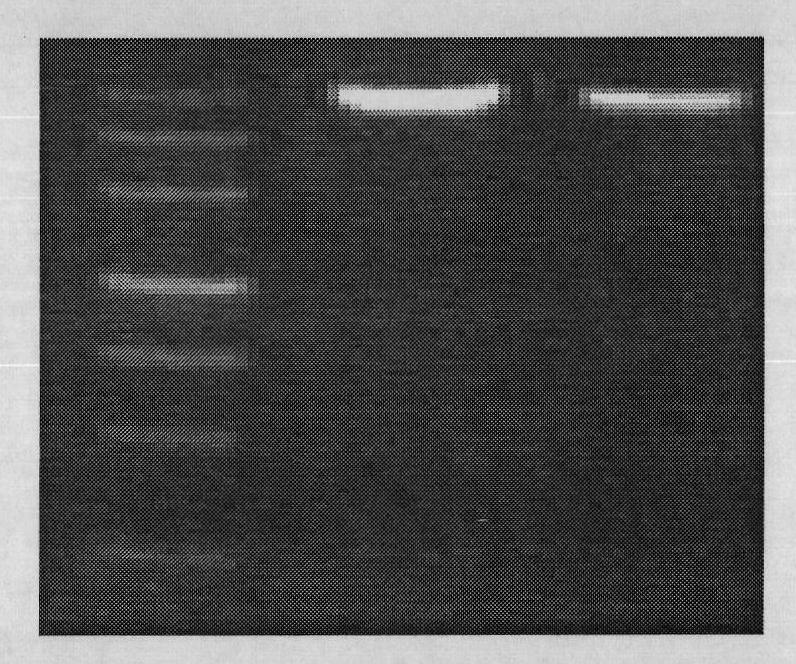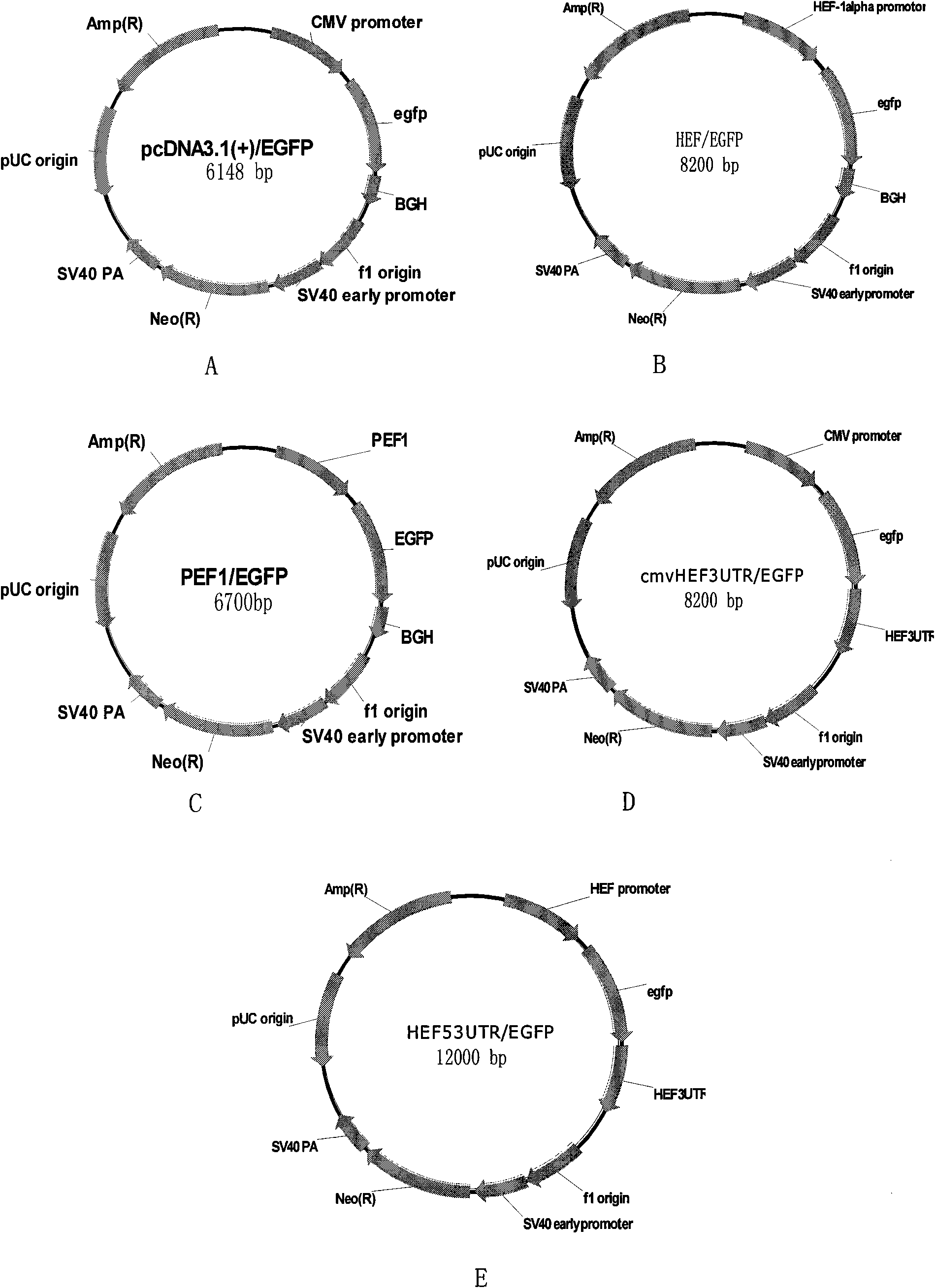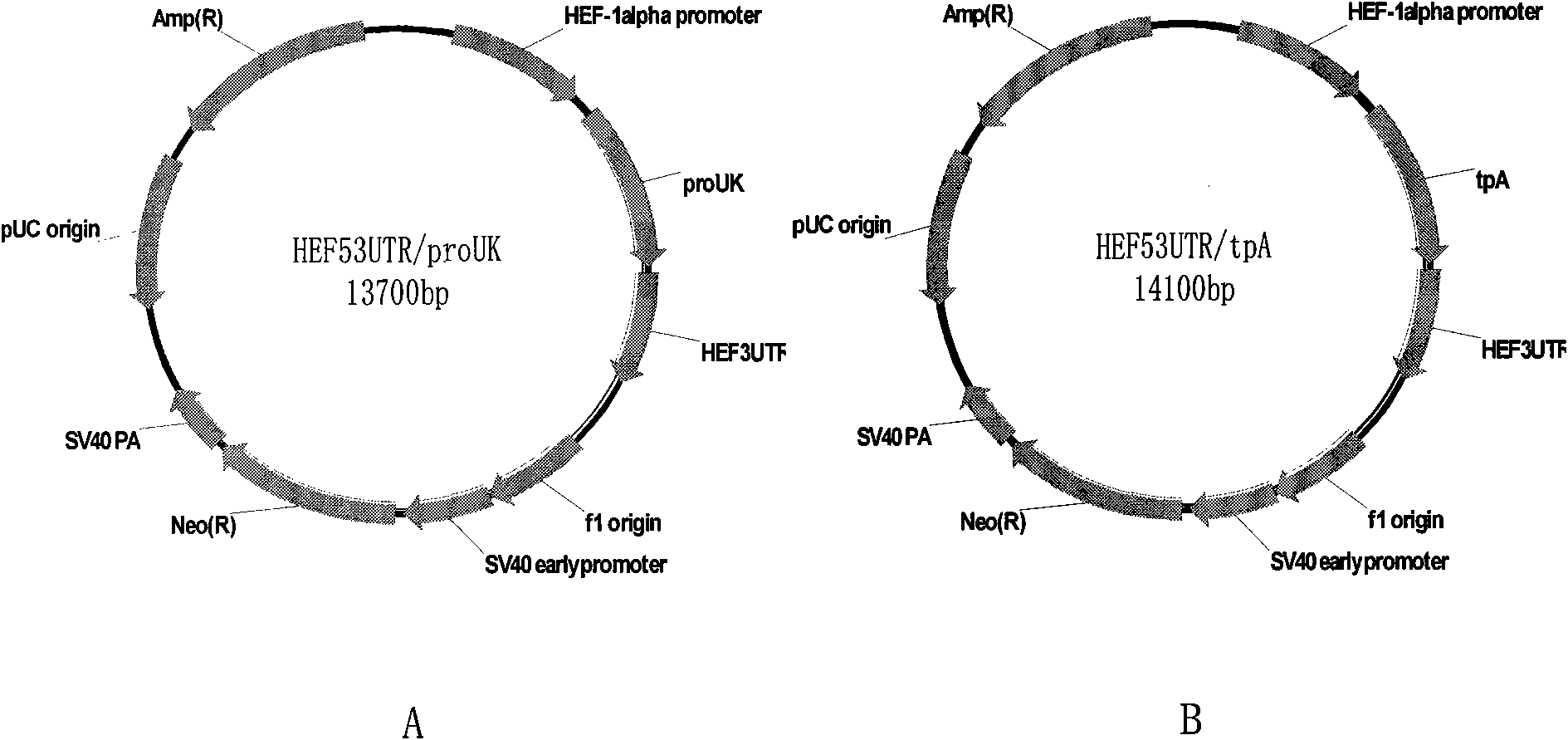Expression vector for efficiently expressing exogenous gene of HEK293 cell
A high-efficiency expression technology of exogenous genes, applied in the direction of introducing foreign genetic material, DNA/RNA fragments, recombinant DNA technology, etc. by using vectors, can solve the problems of silencing effect, weak expression ability not as good as CMV promoter, etc., to promote high-efficiency expression Effect
- Summary
- Abstract
- Description
- Claims
- Application Information
AI Technical Summary
Problems solved by technology
Method used
Image
Examples
Embodiment 1
[0030] Example 1 Cloning of gene transcriptional regulatory sequence of human peptide elongation factor 1.
[0031] 1. Extraction of genomic DNA sequence of HEK293 cells
[0032]HEK293 cells were cultured in D / F medium with 5% serum until the cell square flask was overgrown, and digested with trypsin. Genomic DNA of HEK293 cells was extracted according to the operation manual of TAKARAGeneBall Genome preparation kit.
[0033] 2. Cloning of the gene transcriptional regulatory sequence of human peptide elongation factor 1
[0034] The following primers were designed according to the sequence reported by Genbank, as shown in SEQ ID No.3-6:
[0035] HuEF1 (SEQ ID No. 3): 5-ata acgcgt CCCAAAACAC ATTTACGAGC CTCAACATCGTTACTG-3
[0036] HuEF2 (SEQ ID No. 4): 5-ata gctagc TCA CGACACCTGA AATGGAAGAA AAAAACTTTGAACC-3
[0037] HuEF3 (SEQ ID No. 5): 5-ata tctaga ATATTATCC CTAATACCTG CCACCCCACTCTTAATCAGT GG-3
[0038] HuEF4 (SEQ ID No. 6): 5-ata tccgga CATTAAAAAG TAAGAGATTA CTGATATATACA...
Embodiment 2
[0040] Example 2 Construction of Vectors Containing Different Sequences of Human Peptide Elongation Factor 1
[0041] 1. Reconstruct pCDNA3.1(+)
[0042] Synthesize the following primers:
[0043] BGH1 (SEQ ID No. 7): 5-TCGAGTCTAGAGGGCCCGTTTAAAC-3
[0044] BGH2 (SEQ ID No. 8): 5-ATATCCGGACTCAGAAGCCATAGAGCCCACC-3
[0045] FOR1 (SEQ ID No.9): 5-ATATCCGGAGCGGAAAGAA CCAGCTGGGG-3
[0046] FOR2 (SEQ ID No. 10): 5-TATACAAGCTCCCGGGAGCTTTTTGC-5
[0047] Primer BGH1 contains an XbaI restriction site, BGH2 contains a BspEI restriction site, FOR1 contains a BspEI restriction site, and FOR2 contains an XmaI restriction site. Using pCDNA3.1(+) as a template by PCR method, 200bp and 800bp fragments were respectively amplified. After gel recovery, the 200bp fragments were digested with XbaI and BspEI respectively, the 800bp fragments were digested with BspEI and XmaI, and the 800bp fragments were digested with XbaI and XmaI. After enzyme digestion, the large fragments were recovered from...
Embodiment 3
[0050] Example 3 Vector Transfection of HEK293 Cells and the Measurement of the Fluorescent Expression Intensity of the Reporter Gene EGFP
[0051] One day before transfection, HEK293 cells were treated with 7.5×10 5 Cells were plated in a 6-well plate, and the cells were cultured overnight, and the expression vectors pcDNA3.1 / EGFP and pcDNAPEF / EGFP, pcDNA HEF5UTR / EGFP, pcDNAHEF5UTR / EGFP / HEF3UTR, pcDNACMV / EGFP / HEF3UTR were transfected into HEK293 cells at an equimolar ratio , transfection reagent with Lipofectamine TM In 2000, the operation method was carried out according to the instructions of the reagents.
[0052] 24 hours after transfection, the cells were digested with trypsin, and a 6-well plate was inoculated into a 24-well plate. After 24 hours, after the cells adhered to the wall, the medium was replaced with antibiotic G418 0.3mg / ml. Change the fluid every 3-4 days. Wait for positive clones to grow out after 2 weeks. Trypsinize, collect positive cells, centrifug...
PUM
 Login to View More
Login to View More Abstract
Description
Claims
Application Information
 Login to View More
Login to View More - Generate Ideas
- Intellectual Property
- Life Sciences
- Materials
- Tech Scout
- Unparalleled Data Quality
- Higher Quality Content
- 60% Fewer Hallucinations
Browse by: Latest US Patents, China's latest patents, Technical Efficacy Thesaurus, Application Domain, Technology Topic, Popular Technical Reports.
© 2025 PatSnap. All rights reserved.Legal|Privacy policy|Modern Slavery Act Transparency Statement|Sitemap|About US| Contact US: help@patsnap.com



